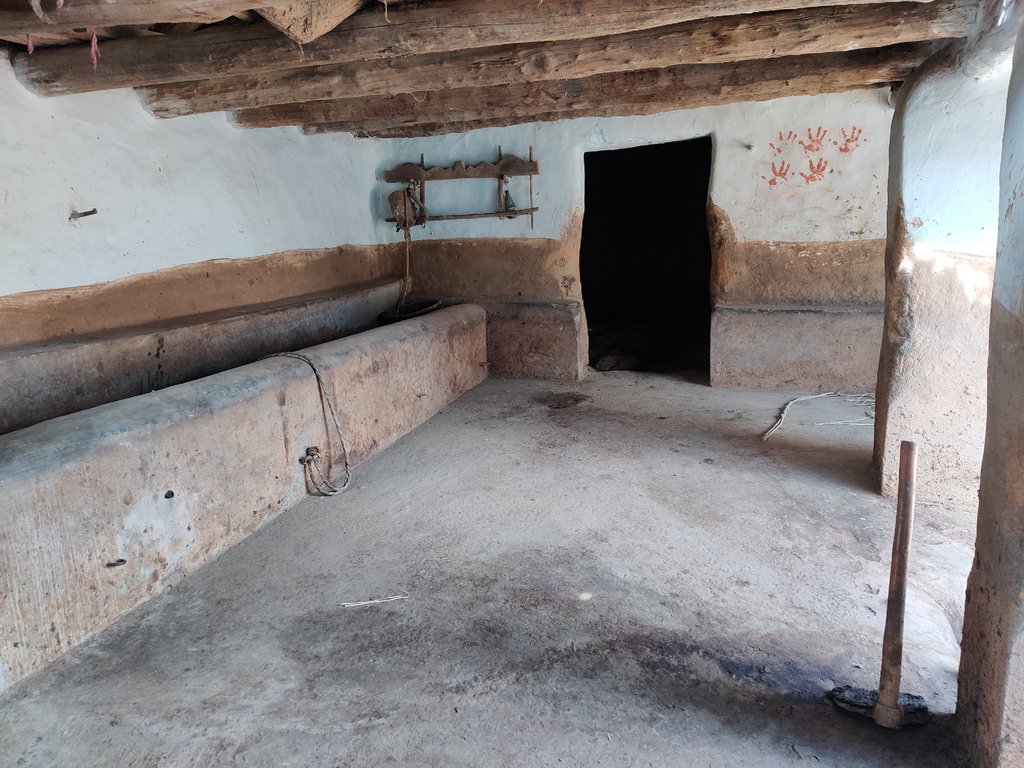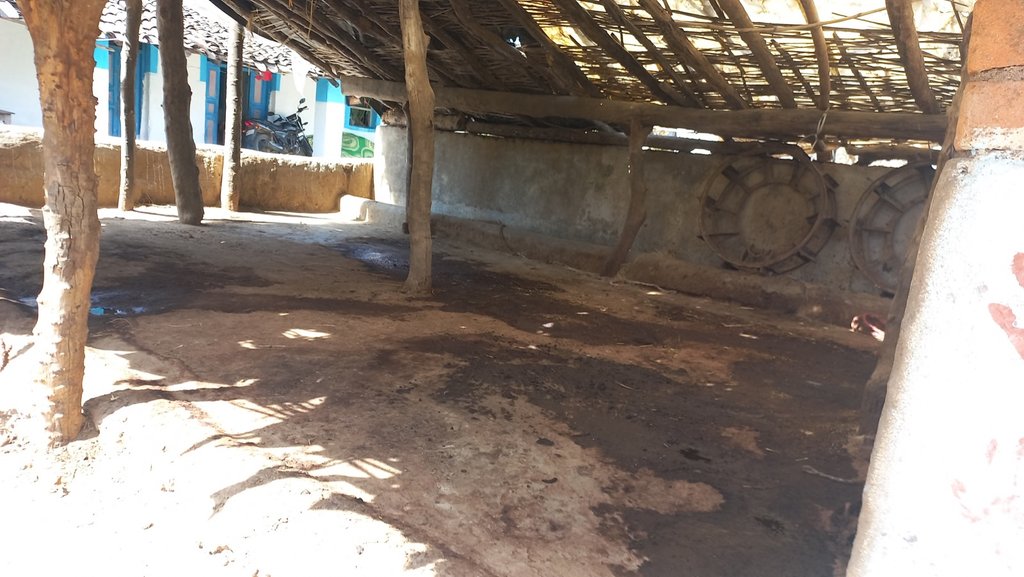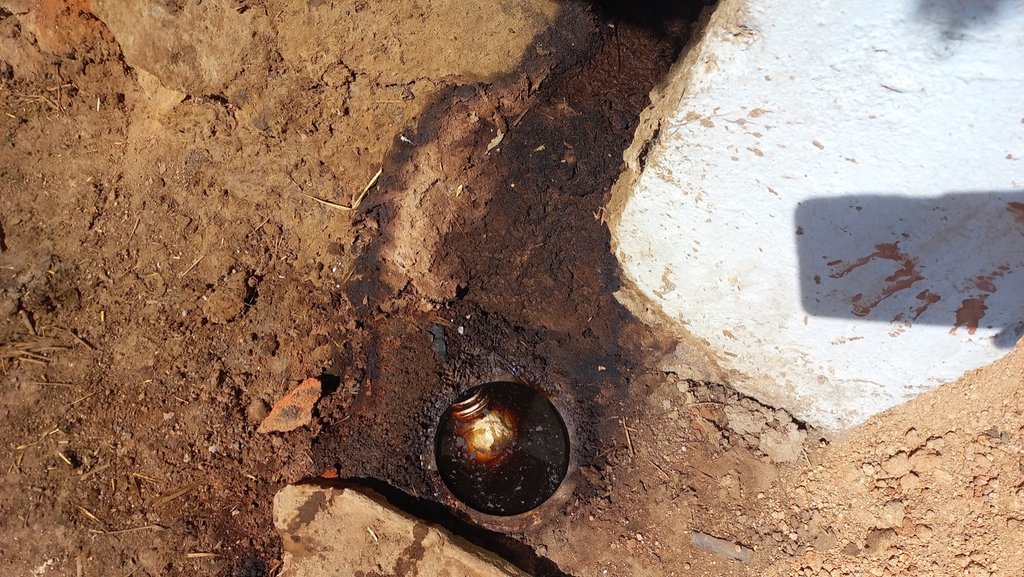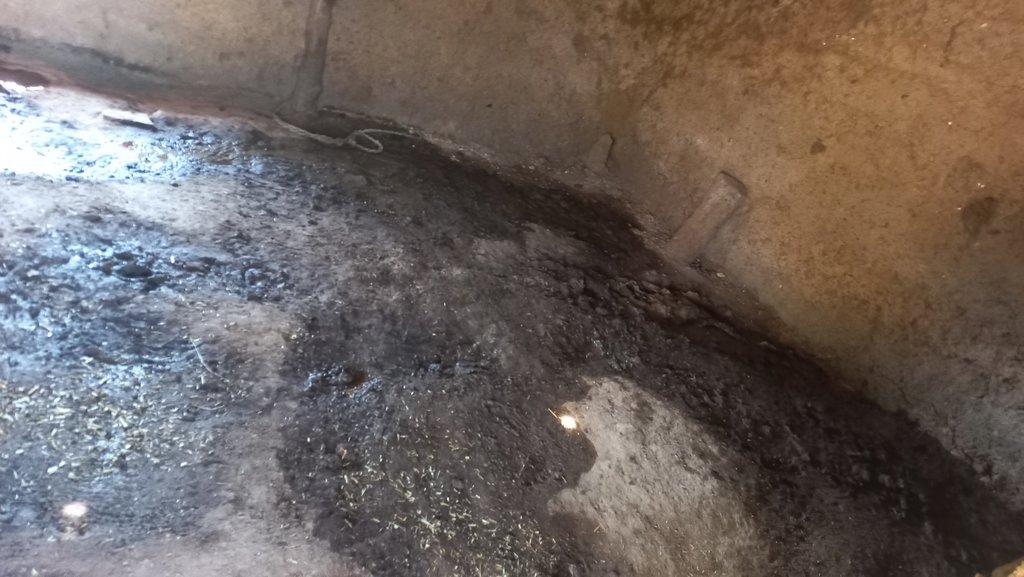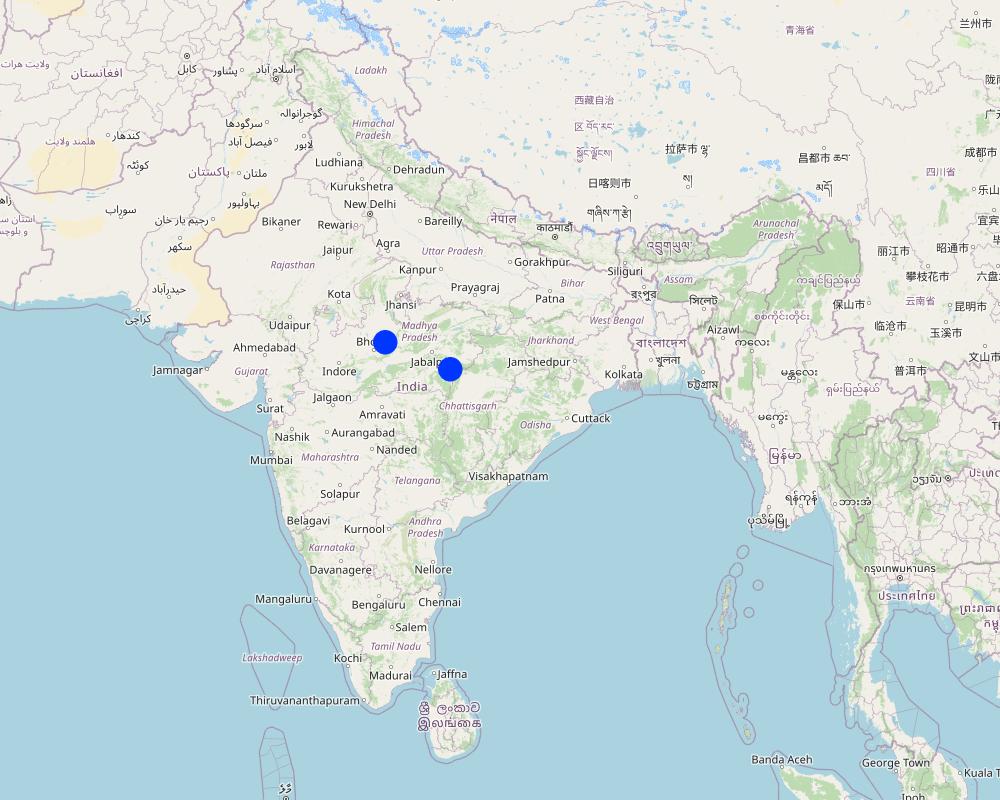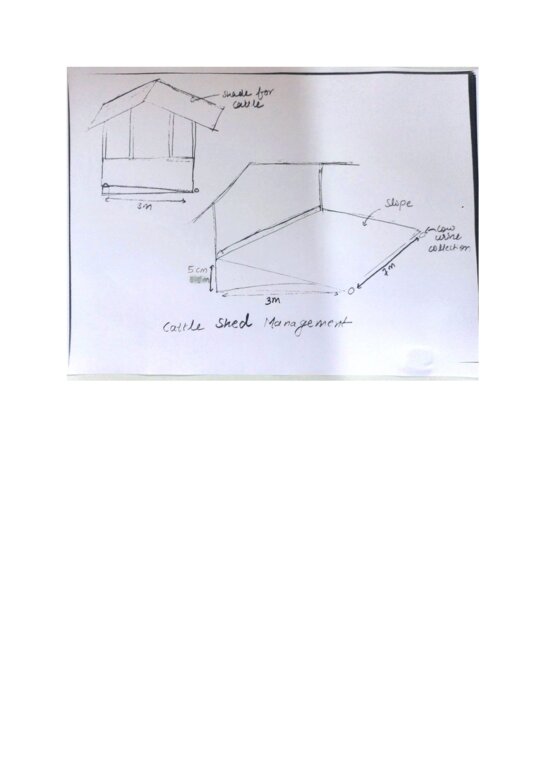Improved Cattle Shed Flooring for Conservation of Cow Dung and Urine for Biofertilizer Production at Farm Level [India]
- Creation:
- Update:
- Compiler: Santosh Gupta
- Editors: Noel Templer, Stephanie Katsir, Kim Arora
- Reviewers: Udo Höggel, Joana Eichenberger
technologies_6721 - India
- Full summary as PDF
- Full summary as PDF for print
- Full summary in the browser
- Full summary (unformatted)
- Improved Cattle Shed Flooring for Conservation of Cow Dung and Urine for Biofertilizer Production at Farm Level: Junie 25, 2023 (inactive)
- Improved Cattle Shed Flooring for Conservation of Cow Dung and Urine for Biofertilizer Production at Farm Level: Sept. 14, 2023 (inactive)
- Improved Cattle Shed Flooring for Conservation of Cow Dung and Urine for Biofertilizer Production at Farm Level: April 11, 2024 (public)
View sections
Expand all Collapse all1. General information
1.2 Contact details of resource persons and institutions involved in the assessment and documentation of the Technology
Name of project which facilitated the documentation/ evaluation of the Technology (if relevant)
Soil protection and rehabilitation for food security (ProSo(i)l)Name of the institution(s) which facilitated the documentation/ evaluation of the Technology (if relevant)
Deutsche Gesellschaft für Internationale Zusammenarbeit (GIZ) GmbH (GIZ) - GermanyName of the institution(s) which facilitated the documentation/ evaluation of the Technology (if relevant)
Alliance Bioversity and International Center for Tropical Agriculture (Alliance Bioversity-CIAT) - KenyaName of the institution(s) which facilitated the documentation/ evaluation of the Technology (if relevant)
Ecociate Consultants (Ecociate Consultants) - India1.3 Conditions regarding the use of data documented through WOCAT
The compiler and key resource person(s) accept the conditions regarding the use of data documented through WOCAT:
Ja
1.4 Declaration on sustainability of the described Technology
Is the Technology described here problematic with regard to land degradation, so that it cannot be declared a sustainable land management technology?
Nee
2. Description of the SLM Technology
2.1 Short description of the Technology
Definition of the Technology:
In the cattle shed management system, the cattle shed should be constructed with an elevated concrete floor that slopes slightly toward a cow urine collection point. The collection point should be equipped with a drainage system to easily remove cow dung and urine.
An elevated concrete floor for cow dung and urine collection can improve hygiene, and waste management, and reduce labour costs in cattle sheds. Collected cow urine and cow dung can be used to prepare biological inputs and compost for nutrient and pest management in agriculture.
2.2 Detailed description of the Technology
Description:
Cattle shed management technology, including the use of a concrete elevated floor for cow dung and urine collection, is a cost-effective and efficient technology to support the natural farming system. This technology can be applied in both natural and human environments. In natural environments, such as rural or agricultural areas, cattle sheds are typically used for dairy and farmyard manure production. The use of this technology can improve the hygiene of cattle and their environment, reduce waste and pollution, and promote the sustainable use of natural resources. The cow dung and urine so collected can be used as fertilizer to improve soil quality, and the improved hygiene of the cattle can reduce the risk of diseases spreading to other animals or humans. The use of this technology can help to reduce the negative impacts of cattle farming on the surrounding environment, such as odours and pollution. It can also improve the hygiene of the cattle and their environment, which is important for both animal welfare and public health.
Traditionally farmers were constructing the floors of cattle sheds using mud and soil. These floors absorb the cow urine and the movement of animals also makes holes in it because of that cow urine and cow dung are used to get filled in these halls. Which made the entire floor unhygienic for both animals and farmers. Because of such surfaces, it was very hard to clean these sheds. The use of an elevated floor made with cement-concrete and a waste management system can help to keep the cattle shed clean and dry, which can reduce the risk of disease and infection among the animals. The collection and disposal of cow dung and urine can help preventing environmental pollution, reducing the negative impacts of cattle farming on the surrounding area, and promoting sustainable use of natural resources. The use of a concrete elevated floor can make cleaning the cattle shed faster and easier, reducing labour costs and improving the efficiency of the farming operation.
Technical specifications for the construction of cattle sheds can vary depending on factors such as the size of the herd, local environmental regulations, and available resources. However, in general, the main characteristics and elements of cattle shed management technology are designed to promote animal welfare, hygiene, waste management, and sustainability. Proper cattle shed management technology can provide a comfortable and safe environment for the animals, which can reduce stress and promote animal welfare. Proper waste management and ventilation can help to minimize unpleasant odours from the cattle shed, which thus reduces negative impacts on the surrounding community.
Establishing and maintaining cattle shed management technology requires a combination of technical expertise, labour, and resources. By investing in these inputs, farmers can promote sustainable and efficient cattle farming practices and improve the health and welfare of their animals.
The collected cow urine and cow dung are the main resources for preparing the biological inputs and different types of compost for meeting the nutritional requirement of crops while also addressing the challenges of pest and disease management in a natural or organic farming system. The improved flooring of cow shed units has been a great intervention to replace and reduce the usage of synthetic fertilisers and pesticides in the project region.
The views of land users, such as farmers or livestock keepers, about cattle shed management technology, including the use of a concrete elevated floor for cow dung and urine collection, can vary depending on their experiences and perceptions. The interviewed land user liked or appreciated, cattle shed management for improving animal health and productivity, increasing farm profitability, cleaning the cattle shed easier and faster, reducing labour costs, improving efficiency, and for environmental benefits.
2.3 Photos of the Technology
General remarks regarding photos:
All of these phots have been taken with the consent of participants.
2.4 Videos of the Technology
Comments, short description:
https://youtube.com/watch?v=Gd6u8yZ9DqY&si=EnSIkaIECMiOmarE
Date:
01/02/2021
Location:
Mandla, Madhya Pradesh, India
Name of videographer:
Soil Matters
2.5 Country/ region/ locations where the Technology has been applied and which are covered by this assessment
Country:
India
Region/ State/ Province:
Madhya Pradesh
Further specification of location:
Mandla District
Specify the spread of the Technology:
- applied at specific points/ concentrated on a small area
Is/are the technology site(s) located in a permanently protected area?
Nee
Comments:
The technology is being adopted by more than 100 farmers across the 10-15 villages of the Bichhiya block in Mandla District of Madhya Pradesh
Map
×2.6 Date of implementation
If precise year is not known, indicate approximate date:
- less than 10 years ago (recently)
2.7 Introduction of the Technology
Specify how the Technology was introduced:
- through projects/ external interventions
Comments (type of project, etc.):
Initially, the project supported the farmers in the construction of cemented cow shed floors in a limited area. However, there has also been investment from the users either by putting extra funds to extend the area or by contributing labour.
3. Classification of the SLM Technology
3.1 Main purpose(s) of the Technology
- improve production
- reduce, prevent, restore land degradation
- conserve ecosystem
- create beneficial economic impact
- Control cattle diseases
3.2 Current land use type(s) where the Technology is applied
Land use mixed within the same land unit:
Nee

Cropland
- Annual cropping
Annual cropping - Specify crops:
- cereals - maize
- cereals - rice (wetland)
- cereals - wheat (winter)
- legumes and pulses - lentils
- oilseed crops - sunflower, rapeseed, other
- vegetables - leafy vegetables (salads, cabbage, spinach, other)
Number of growing seasons per year:
- 2
Specify:
In kharif (summer) season farmers are sowing paddy in wetlands and in rabi (winter) season wheat, chickpea, mustard, maize and other vegetables
Is intercropping practiced?
Ja
If yes, specify which crops are intercropped:
Chickpea intercropping with beans, mixed cropping system of vegetables present
Is crop rotation practiced?
Ja
If yes, specify:
Rice- Chickpea
Rice-Wheat
Rice- Maize
Comments:
The intervention is mostly focused on improved cattle shed units. However, collected cow urine and cow dung are good for restoring the degraded agricultural land.
3.3 Has land use changed due to the implementation of the Technology?
Has land use changed due to the implementation of the Technology?
- No (Continue with question 3.4)
3.4 Water supply
Water supply for the land on which the Technology is applied:
- mixed rainfed-irrigated
Comments:
For irrigation, most of the farmers were dependent upon rain in the Kharif and Rabi season. Some of the farmers were using additional irrigation during critical crop stages by using water canals.
3.5 SLM group to which the Technology belongs
- integrated crop-livestock management
- integrated soil fertility management
3.6 SLM measures comprising the Technology

agronomic measures
- A2: Organic matter/ soil fertility
- A6: Residue management
A6: Specify residue management:
A 6.4: retained

structural measures
- S9: Shelters for plants and animals

management measures
- M6: Waste management (recycling, re-use or reduce)
Comments:
The implemented technology led to the management and use of waste for productive purposes. While it has improved the productivity of animals by reducing the occurrence of diseases, it has also enabled the preparation of organic inputs to replace the synthetic fertilisers in farming.
3.7 Main types of land degradation addressed by the Technology

chemical soil deterioration
- Cn: fertility decline and reduced organic matter content (not caused by erosion)

biological degradation
- Bp: increase of pests/ diseases, loss of predators

water degradation
- Hp: decline of surface water quality
- Hq: decline of groundwater quality
Comments:
Proper collection of cow dung and cow urine minimised run-off these substance and mixing with surface water used for various purposes including drinking water.
3.8 Prevention, reduction, or restoration of land degradation
Specify the goal of the Technology with regard to land degradation:
- prevent land degradation
- reduce land degradation
Comments:
Application of cow urine and cow dung in soil by mixing with other organic matters improves the soil health and also reduces the dependency on synthetic fertilisers and pesticides
4. Technical specifications, implementation activities, inputs, and costs
4.1 Technical drawing of the Technology
Technical specifications (related to technical drawing):
Dimensions of the cowshed (depending on the number of cows kept):
Length: 7m
Width: 3m
Elevated: 5 cm (means in effect the slope: i.e. the front floor of the cowshed is 5 cm higher than the floor at the end, where dung and urine get collected)
Author:
Payal Dewangan
Date:
22/02/2023
4.2 General information regarding the calculation of inputs and costs
Specify how costs and inputs were calculated:
- per Technology unit
Specify unit:
one cattle shed
Specify dimensions of unit (if relevant):
meter
other/ national currency (specify):
Indian Rupee
If relevant, indicate exchange rate from USD to local currency (e.g. 1 USD = 79.9 Brazilian Real): 1 USD =:
82.24
Indicate average wage cost of hired labour per day:
240
4.3 Establishment activities
| Activity | Timing (season) | |
|---|---|---|
| 1. | Concrete floor construction for cattle shed | March |
| 2. | Cattle shed roof development | April |
4.4 Costs and inputs needed for establishment
If you are unable to break down the costs in the table above, give an estimation of the total costs of establishing the Technology:
28000.0
If land user bore less than 100% of costs, indicate who covered the remaining costs:
Gram Paryavaran Samiti and Prakritik Sansadhan Prabhandhan Samiti
Comments:
Village groups were formed for the implementation of the technology
4.5 Maintenance/ recurrent activities
| Activity | Timing/ frequency | |
|---|---|---|
| 1. | Cleaning of concrete floor | Once in a day |
| 2. | Collection of cow dung | Once in a day |
| 3. | collection of cow urine from the pit or drum | Twice in a week |
| 4. | Fodder and drinking water provision | Twice in a day |
4.7 Most important factors affecting the costs
Describe the most determinate factors affecting the costs:
Design and technical specifications: The cost of the technology can vary depending on the design and technical specifications of the cattle shed, including the size and materials used.
Construction materials and labor costs: The cost of construction materials and labor can vary depending on local market conditions and availability.
Location: The cost of transporting materials and labor to the construction site can vary depending on the location of the farm.
Maintenance and repair costs: The cost of maintaining and repairing the cattle shed can also add to the overall cost of the technology.
Training and capacity building: Providing training and capacity building to farmers and workers on proper cattle shed management techniques can add to the overall cost of the technology.
5. Natural and human environment
5.1 Climate
Annual rainfall
- < 250 mm
- 251-500 mm
- 501-750 mm
- 751-1,000 mm
- 1,001-1,500 mm
- 1,501-2,000 mm
- 2,001-3,000 mm
- 3,001-4,000 mm
- > 4,000 mm
Specify average annual rainfall (if known), in mm:
1427.00
Specifications/ comments on rainfall:
Highest rainfall occurs between June to September.
Indicate the name of the reference meteorological station considered:
Mandla, Madhya Pradesh
Agro-climatic zone
- semi-arid
The climate of the District is tropical, with moderate winters, severe summers, and well-distributed rainfall received from the southwest monsoon. However, due to higher general elevation and abundance of forests, summer temperatures do not rise as much as in other areas.
5.2 Topography
Slopes on average:
- flat (0-2%)
- gentle (3-5%)
- moderate (6-10%)
- rolling (11-15%)
- hilly (16-30%)
- steep (31-60%)
- very steep (>60%)
Landforms:
- plateau/plains
- ridges
- mountain slopes
- hill slopes
- footslopes
- valley floors
Altitudinal zone:
- 0-100 m a.s.l.
- 101-500 m a.s.l.
- 501-1,000 m a.s.l.
- 1,001-1,500 m a.s.l.
- 1,501-2,000 m a.s.l.
- 2,001-2,500 m a.s.l.
- 2,501-3,000 m a.s.l.
- 3,001-4,000 m a.s.l.
- > 4,000 m a.s.l.
Indicate if the Technology is specifically applied in:
- not relevant
Comments and further specifications on topography:
The topography of the project area consists of a hilly area and a forest area. Mandla District is hilly and forested (Satpura hill range) and highly undulating with a narrow strip of cultivated plains in the valley portion of the river. The plateau is in the northern part formed by basalt, and east-west trending hills in the southern part. The highest elevation is 934 m amsl in the northern part, and the lowest is around 400 m amsl in the northwestern part of the area. The elevation of the studied block Bichhiya is 453 m amsl.
Source: District at a Glance; Ministry of Water Resources, Government of Madhya Pradesh
5.3 Soils
Soil depth on average:
- very shallow (0-20 cm)
- shallow (21-50 cm)
- moderately deep (51-80 cm)
- deep (81-120 cm)
- very deep (> 120 cm)
Soil texture (topsoil):
- coarse/ light (sandy)
- medium (loamy, silty)
Soil texture (> 20 cm below surface):
- medium (loamy, silty)
Topsoil organic matter:
- low (<1%)
If available, attach full soil description or specify the available information, e.g. soil type, soil PH/ acidity, Cation Exchange Capacity, nitrogen, salinity etc.
Soil Testing Parameter status (Average) 2017-20 for the project areas is as follows. This data is based on the soil samples tested by the FES in its soil labs from the project villages.
Sail pH:-5.906548628; EC (electrical conductivity): 0.122993577: Soil Organic Carbon: 0:83%; Nitrogen:- 293.3696598; Phosphorus:- 25.77762582; Potassium (K):- 139.6696636: Sulphur
(S)-18.93457993; Zinc (Zn):-0.955246706; Boron (Bn):-0.490850376
5.4 Water availability and quality
Ground water table:
> 50 m
Availability of surface water:
medium
Water quality (untreated):
poor drinking water (treatment required)
Water quality refers to:
both ground and surface water
Is water salinity a problem?
Nee
Is flooding of the area occurring?
Nee
Comments and further specifications on water quality and quantity:
The groundwater status is within the safe limits as per the reports by the Government of Madhya Pradesh. People use water from rivers, streams, and traditional small wells for domestic purposes. In the absence of good vegetative cover, the rainwater washes off the fertile topsoil from the farmlands making the land barren and resulting in the siltation of ponds and other water bodies. Further, a heavy infestation of invasive species such as Lantana Camara compounds the degradation.
The studied block Bichhiya is in a better position in terms of stage of groundwater development with 17%, stage of groundwater development refers to the % of groundwater being used for various purposes from the available groundwater in that area e.g. net annual groundwater availability in Bichhiya block is 9087 ham (hectare meters) while the existing annual groundwater draft for all usage is 1523 ham, making it a 17% groundwater development stage, while the district average is 79%.
Source: http://cgwb.gov.in/District Profile/MP/Mandla.pdf
5.5 Biodiversity
Species diversity:
- high
Habitat diversity:
- high
Comments and further specifications on biodiversity:
The cattle shed management unit or center is present nearby the forest area of Kanha National Park. There is high biodiversity present in the technology implementation area. Ecological assessment report in Mandla (where this Technology is applied) showed improved biodiversity on common lands under village governance compared to open-access or commons under government ownership. On average, the Shannon Diversity Index of managed common lands was 1.45 compared to 0.42 for the open access of ungoverned commons. Most of the sites under open access lands are infested by Lantana Camara, which is the main reason for the lower biomass and diversity of the ungoverned lands.
5.6 Characteristics of land users applying the Technology
Sedentary or nomadic:
- Sedentary
Market orientation of production system:
- mixed (subsistence/ commercial)
Off-farm income:
- > 50% of all income
Relative level of wealth:
- poor
Individuals or groups:
- groups/ community
Level of mechanization:
- manual work
- animal traction
Gender:
- women
- men
Age of land users:
- youth
- middle-aged
5.7 Average area of land used by land users applying the Technology
- < 0.5 ha
- 0.5-1 ha
- 1-2 ha
- 2-5 ha
- 5-15 ha
- 15-50 ha
- 50-100 ha
- 100-500 ha
- 500-1,000 ha
- 1,000-10,000 ha
- > 10,000 ha
Is this considered small-, medium- or large-scale (referring to local context)?
- small-scale
5.8 Land ownership, land use rights, and water use rights
Land ownership:
- individual, titled
Land use rights:
- individual
Water use rights:
- communal (organized)
- individual
Are land use rights based on a traditional legal system?
Ja
Specify:
Some of the land parcels are ancestral land units while some have been transferred into private ownership by the State Government over the years
5.9 Access to services and infrastructure
health:
- poor
- moderate
- good
education:
- poor
- moderate
- good
technical assistance:
- poor
- moderate
- good
employment (e.g. off-farm):
- poor
- moderate
- good
markets:
- poor
- moderate
- good
energy:
- poor
- moderate
- good
roads and transport:
- poor
- moderate
- good
drinking water and sanitation:
- poor
- moderate
- good
financial services:
- poor
- moderate
- good
6. Impacts and concluding statements
6.1 On-site impacts the Technology has shown
Socio-economic impacts
Production
crop production
Comments/ specify:
It was observed and noted from the field site that instead of using chemicals, the application of cow urine and cow dung in the form of farm yard manure has helped in improved production as it led to the reduction of pest infestation and better nutrient uptake from the soil.
crop quality
Comments/ specify:
Reduction in the use of chemicals in the field and application of collected cow urine and other bioresource products made from cow dung helped in improving the quality of crop in terms of harder crops, good weight of grain, test etc.
animal production
Comments/ specify:
The improved cattle shed played a crucial role in maintaining the hygiene of animal sheds, which led to the lesser occurrence of disease among animals. Also, the stress level of animals due to the presence of insects and flies reduced significantly. A combination of all these factors improved the milk yield.
risk of production failure
Comments/ specify:
Using sustainable methods for crop production by application of bio inputs not only helps in increasing soil fertility but also contributes to increasing crop resistance, pest control, and better crop development.
product diversity
Income and costs
expenses on agricultural inputs
Comments/ specify:
Reduced to some extent as now farmers can make their own bio-inputs using the cow urine and cow dung collected from the cattle shed
farm income
Comments/ specify:
A combination of improved productivity, reduced cost towards agriculture inputs and better milk productivity has helped farmers in improving their income.
diversity of income sources
Comments/ specify:
Some of the farmers have initiated their own bio resource centres to sell cow urine and cow dung-based bio-inputs, vermicompost etc.
workload
Comments/ specify:
The workload of women members in the household was reduced very significantly due to covering the mud-based cow floor with cement-concrete-based cow floor, earlier cleaning of the cow dung and cow urine used to take a lot of the time. However with new floor, it can be cleaned in less than 5 minutes saving almost an hour in a day.
Socio-cultural impacts
food security/ self-sufficiency
health situation
Comments/ specify:
Improved hygiene is good for both animal and human health
cultural opportunities
community institutions
Ecological impacts
Soil
soil moisture
Comments/ specify:
Application of cow dung, compost and other bio-inputs have improved the soil moisture
nutrient cycling/ recharge
Comments/ specify:
Application of cow dung, compost and other bio-inputs will help in improving the nutrient cycling in the soil and will enhance the soil microbial activities
Climate and disaster risk reduction
emission of carbon and greenhouse gases
Comments/ specify:
Some of the farmers are using the collected cow dung as an input for their 'Bio-gas' plants. Thus, the use of biogas plants not only reduces the use of fire wood and LPG for cooking but its waste (slurry) is also used as inputs for agriculture fields. Thus reducing the overall footprint of GHG emission.
6.2 Off-site impacts the Technology has shown
damage on neighbours' fields
impact of greenhouse gases
Comments/ specify:
Some of the farmers have installed bio gas plants. Use of biogas plants not only reduces the use of fire wood and LPG for cooking but its waste (slurry) is also used as inputs for Some of the farmers are using the collected cow dung as an input for their 'Bio-gas' plants agriculture fields. Thus reducing the overall footprint of GHG emission.
Also the improved floor have helped in proper collection of cow dung and cow urine for the purpose of composting. Composting makes the compounds in manure more stable and therefore reduces the amount that is released into the atmosphere.
6.3 Exposure and sensitivity of the Technology to gradual climate change and climate-related extremes/ disasters (as perceived by land users)
Gradual climate change
Gradual climate change
| Season | increase or decrease | How does the Technology cope with it? | |
|---|---|---|---|
| annual temperature | increase | very well |
6.4 Cost-benefit analysis
How do the benefits compare with the establishment costs (from land users’ perspective)?
Short-term returns:
negative
Long-term returns:
positive
How do the benefits compare with the maintenance/ recurrent costs (from land users' perspective)?
Short-term returns:
slightly negative
Long-term returns:
very positive
Comments:
Low maintenance cost compared with benefits of higher animal productivity and hygienic living
6.5 Adoption of the Technology
- 1-10%
Of all those who have adopted the Technology, how many did so spontaneously, i.e. without receiving any material incentives/ payments?
- 0-10%
6.6 Adaptation
Has the Technology been modified recently to adapt to changing conditions?
Nee
6.7 Strengths/ advantages/ opportunities of the Technology
| Strengths/ advantages/ opportunities in the land user’s view |
|---|
| Reduced labour of urine and dung collection |
| Better animal management |
| Strengths/ advantages/ opportunities in the compiler’s or other key resource person’s view |
|---|
| Reduced GHG emission because of better handling of dung and urine |
| Increased productivity because of the use of animal manure |
6.8 Weaknesses/ disadvantages/ risks of the Technology and ways of overcoming them
| Weaknesses/ disadvantages/ risks in the land user’s view | How can they be overcome? |
|---|---|
| High establishment cost | Subsidies and grants |
| Regular maintenance cost | Technological innovation |
| Weaknesses/ disadvantages/ risks in the compiler’s or other key resource person’s view | How can they be overcome? |
|---|---|
| Possibilities of disadoption because of maintenance cost | Increase returns of the units by extending new products from Urine and dung |
| No demand | Increase communication and extension on the benefits of different products from animals |
7. References and links
7.1 Methods/ sources of information
- interviews with land users
7.2 References to available publications
Title, author, year, ISBN:
Repairing cattle shed floor
Available from where? Costs?
Foundation for Ecological Security, Mandla, MP, India
7.3 Links to relevant online information
Title/ description:
Cattle sheds: one intervention, several benefits for farmers
URL:
https://www.youtube.com/watch?v=Gd6u8yZ9DqY
Links and modules
Expand all Collapse allLinks
No links
Modules
No modules



